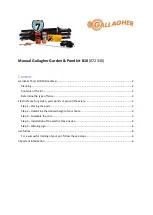
37
Analysis
9 .5 Component Test
The R&S®HMO1002 resp. R&S®HMO1202 series has a
built-in component tester. This can be activated by pushing
the UTIL button (VERTICAL section) with the soft menu
key COMP. TEST. The unit under test is connected via AUX
OUT connector and BNC/Banana adapter (e.g. HZ20). After
switch on the
component tester mode, the Y preamplifiers
and the time base are disconnected. While using the com-
ponent tester, signals may be present at the inputs as long
as the unit under test is not connected to any other circuit.
It is possible to test components remaining in their circuits,
but in such cases all signals must be disconnected from the
front panel BNC connectors (see the following paragraph:
„Test in circuits“). The test principle is a generator within
the R&S®HMO1002 resp. R&S®HMO1202 series generates
a 50 Hz or 200 Hz (±10 %) sine wave which feeds the series
connection of the test object and a sense resistor. If the test
object has only a real part such as a resistor, both voltages
will be in phase; the display will be a straight line, more or
less slanted.
Is the test object short-circuited, the line will be vertical
(no voltage, current maximum). If the test object is open-
circuited or missing a horizontal line will appear (voltage,
but no current). The angle of the line with the horizontal is
a measure of the resistance value, allowing for measu-
rements of resistors between Ω and kΩ. Capacitors and
inductors cause phase shift between voltage and current
and hence between the voltages. This will cause displays of
ellipses. The location and the form factor of the ellipse are
determined by the apparent impedance at 50 Hz (resp. 200
Hz). Capacitors can be measured between µF and mF. An
ellipse with its longer axis horizontal indicates a high impe-
dance (small capacitance or large inductance). An ellipse
with its longer axis vertical indicates a low impedance (large
capacitance or small inductance). An ellipse with its longer
axis slanted indicates a relatively large resistive loss in series
with the impedance of the capacitor or inductor.
Fig. 9.9: HZ20 adapter connected to AUX OUT
If components are tested which are located in circuits or instru-
ments, the circuits resp. instruments must be disconnected first!
If they are operated from the mains, the mains plug of the test
object has to be pulled out. This ensures that there will be no
loops between the scope and the test object via the safety earth
which might cause false results.
With semiconductors the transition from the non-conduc-
ting to the conducting state will be indicated in their cha-
racteristic. As far as is possible with the available voltages
and currents the forward and backward characteristics are
displayed (e.g. with zener diodes up to 9 V). Because this is
a two-pole measurement, the gain of a transistor can not
be determined, however, the B-C, B-E, C-E diodes can be
measured. With this exception the diodes can be measu-
red without fear of destruction as the maximum voltage
is limited to 9 V and the current to a few mA. This implies,
however, that a measurement of breakdown voltages > 9 V
is not possible. In general this is no dis-advantage because,
if there is a defect in a circuit, gross deviations are to be ex-
pected which will point to the defective component. Rather
exact results may be achieved if the measurements are
compared to those of intact components. This is especially
true for semiconductors. The polarity of diodes or transis-
tors can thus be identified if the lettering or marking is mis
-
sing. Please note that with semiconductors changing the
polarity will cause the display to rotate 180 degrees around
the screen center. More important in practice is the quick
determination of plain shorts and opens which are the most
common causes of requiring service.
9 .5 .1 In-circuit tests
They are possible in many cases but deliver rarely clear
results. By paralleling of real or complex impedances – es-
pecially if those are fairly low impedance at 50 Hz/200 Hz
– there will be mostly great differences compared to
Only discharged capacitors may be tested!
It is highly recommended to observe the necessary precautions
when handling MOS components which can be destroyed by sta-
tic charges and even tribo electricity.
Fig. 9.10: Component test example.
















































